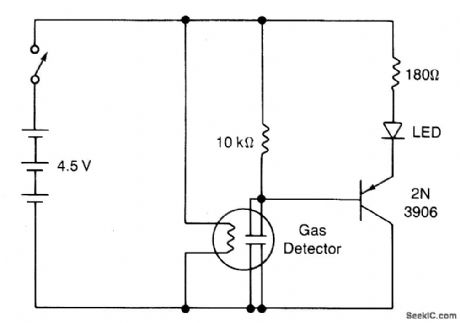Basic Circuit
GAS_ANALYZER
Published:2009/7/1 0:43:00 Author:May | From:SeekIC

The circuit shows a simple yes/no gas detector. Three 1.5-V D cells are used as a power supply, with S1 acting as an on/off switch. The heater is energized directly from the battery, while the electrodes are in series with a 10 k resistor. The voltage across this resistor is monitored by a pnp transistor. When the sensor is in clean air, the resis-tance between the electrodes is about 40 k, so that only about 0.9 V is dropped across the 10 k resistor. This is insufftcient to turn on the transistor, because of the extra 1.6 V required to forward bias the light emitting diode (LED) in series with the emitter. When the sensor comes in contact with contaminated air, the resistance starts to fall, increasing the voltage dropped across the 10 k resistor. When the sensor resistance falls to about 10 k or less, the transistor starts to turn on, current passes through the LED, causing it to emit. The 180 ohm resistor limits the current through the LED to a safe value.
Reprinted Url Of This Article:
http://www.seekic.com/circuit_diagram/Basic_Circuit/GAS_ANALYZER.html
Print this Page | Comments | Reading(3)

Article Categories
power supply circuit
Amplifier Circuit
Basic Circuit
LED and Light Circuit
Sensor Circuit
Signal Processing
Electrical Equipment Circuit
Control Circuit
Remote Control Circuit
A/D-D/A Converter Circuit
Audio Circuit
Measuring and Test Circuit
Communication Circuit
Computer-Related Circuit
555 Circuit
Automotive Circuit
Repairing Circuit
Code: